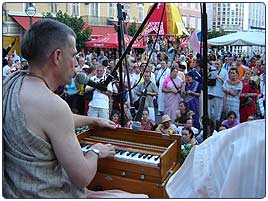Kirtana is ‘In’
By Deva Gaura Hari Dasa | Sep 09, 2007

Across the globe, in rooms that had been home to hatha-yoga exercises, silent meditation, and perhaps the occasional hushed sounds of “Om”, local musicians, and professional singers like Krishna das and Jai Uttal, are rattling the walls and playing to packed houses with the Vedic art of kirtana.
Kirtana is the melodic singing of holy mantras and names of God, predominantly in the Sanskrit language. It is usually performed in a call and response fashion, with one person leading the chant.
In many traditions in India, kirtana has always been an important part of religious festivals; but it wasn’t until the 15th century saint Sri Caitanya Mahaprabhu introduced the sankirtana movement that the practice of kirtana became the centrepiece for the spiritual experience of millions of people across the sub-continent.
Prior to the twentieth century, however, kirtana had hardly been known outside the boundaries of India. In 1966, when an unknown Indian holy man, a spiritual master coming in a disciplic line from Sri Caitanya, sat down in Tompkins Square Park, New York, took up a small pair of hand cymbals and began singing kirtana, nobody in the small crowd that gathered had heard the exotic sounds before. It was a sublime, yet foreign experience, as the listeners heard the strange Sanskrit mantras for the first time.
In 1966 Srila Prabhupada introduced kirtana to the western world in New York’s Thompkins Square Park.
Video courtesy of Richard Witty.
Many of those listening that day were hippies; young seekers in search of new experiences in consciousness, willing to accept any new far-out thing that came from the east. Some joined in the kirtana because it was another way to get high.
Yet there were those who took the holy man’s teachings seriously and began to put them into practice. Within a few short years Srila Prabhupada, as he later came to be known, had a following in the thousands. To organise the spreading of Sri Caitanya’s kirtana movement around the world, Srila Prabhupada founded the International Society for Krishna Consciousness (ISKCON), and throughout the ‘70’s and ‘80’s, the residents of the major cities of the world would often see the ‘Hare Krishnas’ performing kirtana along their streets and sidewalks.
Now, as we head into the new millennium, a new type of spiritual seeker is looking for solace in the soothing vibrations of the kirtana. Not necessarily looking to give up their jobs and become full-time spiritualists, they join in the kirtana to relieve the stress of their busy lives, and experience the joy of participation in the kirtana. Far from being hippies, these new kirtana seekers are often professionals, looking for a way to relieve stress and experience the inner peace that kirtana offers.
In a 2003 article in Time magazine, lawyers, computer specialists and financial advisors were asked why they attended the kirtanas, and their responses included, “The stress melts in my body”, “It’s a combination of grounding and ecstasy” and “It’s empowering to sing with others who experience the process with you.” Attendees also liked the fact that kirtana has something of the feelings and sound vibrations of a music concert, but instead of just watching someone up on a stage, in the kirtana you are an active participant.
Jeanette Hausser of the Integral Yoga Institute in New York City reports that more people continue to attend the kirtanas. “We get a full house of 120 people when Jai Uttal is in town, otherwise we’ve noticed that the attendance is steadily increasing.”
Ali Sachedina, manager of Jai Uttal confirms the rise of kirtana, “There’s been a tremendous increase in CD sales and performance bookings for Jai Uttal over past 5 or 6 years. People are understanding the need for culture so they look towards the eastern practices like kirtana, yoga and meditation. Here in New York, harmoniums (small keyboard instruments often used in kirtana) are selling as fast as we can get them into the country.”
While the Vedic literature often glorifies the performance of kirtana under any circumstances, it does recommend that kirtana should be lead by a person who has been trained in an authentic bhakti-yoga (the yoga of devotion) tradition, leads a pure life, abstains from intoxication, meat eating, illicit sex and gambling.
The Vedas explain that if one sings these holy sounds even without such study, then one will still experience a sense of peace and relief from anxiety, as reported in Time magazine.
However, the Vedas further advise that if one hears the kirtana from a person who understands the deeper meaning of the kirtana, they not only have the opportunity to relieve their stress but to awaken their dormant love for God, which leads to ultimate liberation.
Whichever way one approaches kirtana, it is clear that it is becoming more widespread, and more widely accepted as an excellent way to relieve stress and connect with the spiritual dimension of our lives.
Related articles: Chanters Trade Sleep for Inspiration at New Vrindavan 24 Hour Kirtan Festival, The 23rd Hour















